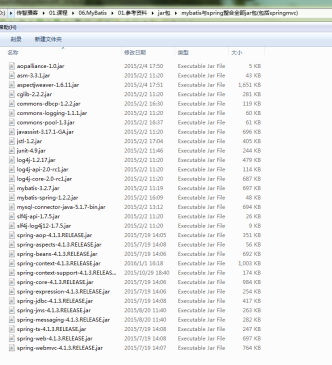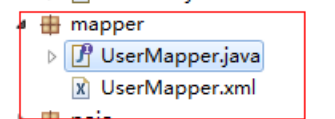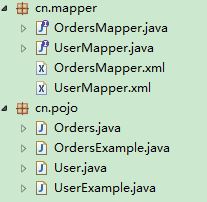一、整合思路
1、SqlSessionFactory对象应该放到spring容器中作为单例存在。
2、传统dao的开发方式中,应该从spring容器中获得sqlsession对象。
3、Mapper代理形式中,应该从spring容器中直接获得mapper的代理对象。
4、数据库的连接(数据源)以及数据库连接池事务管理都交给spring容器来完成。
二、整合所需jar包
1、spring的jar包
2、Mybatis的jar包
3、Spring+mybatis的整合包。
4、Mysql的数据库驱动jar包。
5、数据库连接池的jar包。

//可能会有一些多余的jar包,此处暂作忽略(补充maven整合! )
三、整合步骤
第一步:创建一个java工程。
目录结构如下:

//遵循maven项目结构
第二步:导入jar包。(上面提到的jar包)
(此处放入lib目录,不再赘述)
第三步:mybatis的配置文件sqlMapConfig.xml
<?xml version="1.0" encoding="UTF-8" ?>
<!DOCTYPE configuration
PUBLIC "-//mybatis.org//DTD Config 3.0//EN"
"http://mybatis.org/dtd/mybatis-3-config.dtd">
<configuration>
<typeAliases>
<!-- 定义单个pojo类别名
type:类的全路劲名称
alias:别名
-->
<!-- <typeAlias type="cn.pojo.User" alias="user"/> -->
<!-- 使用包扫描的方式批量定义别名
定以后别名等于类名,不区分大小写,但是建议按照java命名规则来,首字母小写,以后每个单词的首字母大写
-->
<package name="cn.pojo"/>
</typeAliases>
<mappers>
<mapper resource="User.xml"/>
<!--
使用class属性引入接口的全路径名称:
使用规则:
1. 接口的名称和映射文件名称除扩展名外要完全相同
2. 接口和映射文件要放在同一个目录下
-->
<!-- <mapper class="cn.mapper.UserMapper"/> -->
<!-- 使用包扫描的方式批量引入Mapper接口
使用规则:
1. 接口的名称和映射文件名称除扩展名外要完全相同
2. 接口和映射文件要放在同一个目录下
-->
<!-- <package name="cn.mapper"/> -->
</mappers>
</configuration>
//此处的映射文件只是为了演示一下原始DAO的开发方式
第四步:编写Spring的配置文件
1、数据库连接及连接池
2、事务管理(暂时可以不配置)
3、sqlsessionFactory对象,配置到spring容器中

<?xml version="1.0" encoding="UTF-8"?> <beans xmlns="http://www.springframework.org/schema/beans" xmlns:context="http://www.springframework.org/schema/context" xmlns:p="http://www.springframework.org/schema/p" xmlns:aop="http://www.springframework.org/schema/aop" xmlns:tx="http://www.springframework.org/schema/tx" xmlns:xsi="http://www.w3.org/2001/XMLSchema-instance" xsi:schemaLocation="http://www.springframework.org/schema/beans http://www.springframework.org/schema/beans/spring-beans-4.0.xsd http://www.springframework.org/schema/context http://www.springframework.org/schema/context/spring-context-4.0.xsd http://www.springframework.org/schema/aop http://www.springframework.org/schema/aop/spring-aop-4.0.xsd http://www.springframework.org/schema/tx http://www.springframework.org/schema/tx/spring-tx-4.0.xsd http://www.springframework.org/schema/util http://www.springframework.org/schema/util/spring-util-4.0.xsd"> <!-- 加载配置文件 --> <context:property-placeholder location="classpath:db.properties" /> <!-- 数据库连接池 (此时使用的是dbcp,效率不高,仅作演示使用)--> <bean id="dataSource" class="org.apache.commons.dbcp.BasicDataSource" destroy-method="close"> <property name="driverClassName" value="${jdbc.driver}" /> <property name="url" value="${jdbc.url}" /> <property name="username" value="${jdbc.username}" /> <property name="password" value="${jdbc.password}" /> <property name="maxActive" value="10" /> <property name="maxIdle" value="5" /> </bean> <!-- 整合后会话工厂归spring管理 ,class类名在整合jar包第一个包里找,去掉class即是了--> <bean id="sqlSessionFactory" class="org.mybatis.spring.SqlSessionFactoryBean"> <!-- 需要哪些属性直接点开上面的class即可显示(即使未关联源码,下面会有显示) --> <!-- 指定mybatis核心配置文件 --> <property name="configLocation" value="classpath:SqlMapConfig.xml"></property> <!-- 指定会话工厂的数据源 --> <property name="dataSource" ref="dataSource"></property> </bean>
//这里配置sqlSessionFactory时可以回忆工厂是如何得到的,就可以很清楚地知道需要配置注入哪些信息
4、mapeer代理对象或者是dao实现类配置到spring容器中。
Dao的开发
1.传统dao(接口+实现类形式)
dao实现类

package cn.dao; import java.util.List; import org.apache.ibatis.session.SqlSession; import org.mybatis.spring.support.SqlSessionDaoSupport; import cn.pojo.User; public class UserDaoImpl extends SqlSessionDaoSupport implements UserDao { @Override public User findUserById(Integer id) { //sqlSesion是线程不安全的,所以它的最佳使用范围在方法体内 SqlSession openSession = this.getSqlSession(); User user = openSession.selectOne("test.findUserById", id); //整合后会话归spring管理,所以不需要手动关闭. //openSession.close(); return user; } @Override public List<User> findUserByUserName(String userName) { SqlSession openSession = this.getSqlSession(); List<User> list = openSession.selectList("test.findUserByUserName", userName); return list; } }
配置dao交给spring管理
<!-- 配置原生dao实现,id为接口,class为实现类的形式 -->
<bean id="userDao" class="cn.dao.UserDaoImpl">
<property name="sqlSessionFactory" ref="sqlSessionFactory"></property>
</bean>
测试函数

package cn.test; import org.junit.Before; import org.junit.Test; import org.springframework.context.ApplicationContext; import org.springframework.context.support.ClassPathXmlApplicationContext; import cn.dao.UserDao; import cn.pojo.User; public class UserDaoTest { private ApplicationContext applicationContext; //进行初始化 @Before public void setUp() throws Exception{ String configuration = "applicationContext.xml"; applicationContext = new ClassPathXmlApplicationContext(configuration); } @Test public void testfindUserById() throws Exception{ UserDao dao = (UserDao) applicationContext.getBean("userDao"); User user = dao.findUserById(1); System.out.println(user); } }
2.mapper代理形式开发dao
mapper文件编写

UserMapper.java

package cn.mapper; import java.util.List; import org.apache.ibatis.annotations.Param; import cn.pojo.User; import cn.pojo.UserExample; public interface UserMapper { int countByExample(UserExample example); int deleteByExample(UserExample example); int deleteByPrimaryKey(Integer id); int insert(User record); int insertSelective(User record); List<User> selectByExample(UserExample example); User selectByPrimaryKey(Integer id); int updateByExampleSelective(@Param("record") User record, @Param("example") UserExample example); int updateByExample(@Param("record") User record, @Param("example") UserExample example); int updateByPrimaryKeySelective(User record); int updateByPrimaryKey(User record); }
UserMapper.xml

<?xml version="1.0" encoding="UTF-8" ?> <!DOCTYPE mapper PUBLIC "-//mybatis.org//DTD Mapper 3.0//EN" "http://mybatis.org/dtd/mybatis-3-mapper.dtd" > <mapper namespace="cn.mapper.UserMapper" > <resultMap id="BaseResultMap" type="cn.pojo.User" > <id column="id" property="id" jdbcType="INTEGER" /> <result column="username" property="username" jdbcType="VARCHAR" /> <result column="birthday" property="birthday" jdbcType="DATE" /> <result column="sex" property="sex" jdbcType="CHAR" /> <result column="address" property="address" jdbcType="VARCHAR" /> </resultMap> <sql id="Example_Where_Clause" > <where > <foreach collection="oredCriteria" item="criteria" separator="or" > <if test="criteria.valid" > <trim prefix="(" suffix=")" prefixOverrides="and" > <foreach collection="criteria.criteria" item="criterion" > <choose > <when test="criterion.noValue" > and ${criterion.condition} </when> <when test="criterion.singleValue" > and ${criterion.condition} #{criterion.value} </when> <when test="criterion.betweenValue" > and ${criterion.condition} #{criterion.value} and #{criterion.secondValue} </when> <when test="criterion.listValue" > and ${criterion.condition} <foreach collection="criterion.value" item="listItem" open="(" close=")" separator="," > #{listItem} </foreach> </when> </choose> </foreach> </trim> </if> </foreach> </where> </sql> <sql id="Update_By_Example_Where_Clause" > <where > <foreach collection="example.oredCriteria" item="criteria" separator="or" > <if test="criteria.valid" > <trim prefix="(" suffix=")" prefixOverrides="and" > <foreach collection="criteria.criteria" item="criterion" > <choose > <when test="criterion.noValue" > and ${criterion.condition} </when> <when test="criterion.singleValue" > and ${criterion.condition} #{criterion.value} </when> <when test="criterion.betweenValue" > and ${criterion.condition} #{criterion.value} and #{criterion.secondValue} </when> <when test="criterion.listValue" > and ${criterion.condition} <foreach collection="criterion.value" item="listItem" open="(" close=")" separator="," > #{listItem} </foreach> </when> </choose> </foreach> </trim> </if> </foreach> </where> </sql> <sql id="Base_Column_List" > id, username, birthday, sex, address </sql> <select id="selectByExample" resultMap="BaseResultMap" parameterType="cn.pojo.UserExample" > select <if test="distinct" > distinct </if> <include refid="Base_Column_List" /> from user <if test="_parameter != null" > <include refid="Example_Where_Clause" /> </if> <if test="orderByClause != null" > order by ${orderByClause} </if> </select> <select id="selectByPrimaryKey" resultMap="BaseResultMap" parameterType="java.lang.Integer" > select <include refid="Base_Column_List" /> from user where id = #{id,jdbcType=INTEGER} </select> <delete id="deleteByPrimaryKey" parameterType="java.lang.Integer" > delete from user where id = #{id,jdbcType=INTEGER} </delete> <delete id="deleteByExample" parameterType="cn.pojo.UserExample" > delete from user <if test="_parameter != null" > <include refid="Example_Where_Clause" /> </if> </delete> <insert id="insert" parameterType="cn.pojo.User" > insert into user (id, username, birthday, sex, address) values (#{id,jdbcType=INTEGER}, #{username,jdbcType=VARCHAR}, #{birthday,jdbcType=DATE}, #{sex,jdbcType=CHAR}, #{address,jdbcType=VARCHAR}) </insert> <insert id="insertSelective" parameterType="cn.pojo.User" > insert into user <trim prefix="(" suffix=")" suffixOverrides="," > <if test="id != null" > id, </if> <if test="username != null" > username, </if> <if test="birthday != null" > birthday, </if> <if test="sex != null" > sex, </if> <if test="address != null" > address, </if> </trim> <trim prefix="values (" suffix=")" suffixOverrides="," > <if test="id != null" > #{id,jdbcType=INTEGER}, </if> <if test="username != null" > #{username,jdbcType=VARCHAR}, </if> <if test="birthday != null" > #{birthday,jdbcType=DATE}, </if> <if test="sex != null" > #{sex,jdbcType=CHAR}, </if> <if test="address != null" > #{address,jdbcType=VARCHAR}, </if> </trim> </insert> <select id="countByExample" parameterType="cn.pojo.UserExample" resultType="java.lang.Integer" > select count(*) from user <if test="_parameter != null" > <include refid="Example_Where_Clause" /> </if> </select> <update id="updateByExampleSelective" parameterType="map" > update user <set > <if test="record.id != null" > id = #{record.id,jdbcType=INTEGER}, </if> <if test="record.username != null" > username = #{record.username,jdbcType=VARCHAR}, </if> <if test="record.birthday != null" > birthday = #{record.birthday,jdbcType=DATE}, </if> <if test="record.sex != null" > sex = #{record.sex,jdbcType=CHAR}, </if> <if test="record.address != null" > address = #{record.address,jdbcType=VARCHAR}, </if> </set> <if test="_parameter != null" > <include refid="Update_By_Example_Where_Clause" /> </if> </update> <update id="updateByExample" parameterType="map" > update user set id = #{record.id,jdbcType=INTEGER}, username = #{record.username,jdbcType=VARCHAR}, birthday = #{record.birthday,jdbcType=DATE}, sex = #{record.sex,jdbcType=CHAR}, address = #{record.address,jdbcType=VARCHAR} <if test="_parameter != null" > <include refid="Update_By_Example_Where_Clause" /> </if> </update> <update id="updateByPrimaryKeySelective" parameterType="cn.pojo.User" > update user <set > <if test="username != null" > username = #{username,jdbcType=VARCHAR}, </if> <if test="birthday != null" > birthday = #{birthday,jdbcType=DATE}, </if> <if test="sex != null" > sex = #{sex,jdbcType=CHAR}, </if> <if test="address != null" > address = #{address,jdbcType=VARCHAR}, </if> </set> where id = #{id,jdbcType=INTEGER} </update> <update id="updateByPrimaryKey" parameterType="cn.pojo.User" > update user set username = #{username,jdbcType=VARCHAR}, birthday = #{birthday,jdbcType=DATE}, sex = #{sex,jdbcType=CHAR}, address = #{address,jdbcType=VARCHAR} where id = #{id,jdbcType=INTEGER} </update> </mapper>
mapper在spring中的配置(包含包扫描的方式【推荐】)
<!-- 此法略显麻烦,若有多个mapper,则配置mapper暴增 -->
<!-- mapper动态代理实现,在整合包的mapper包下找,删除.class后缀即可 -->
<!-- <bean id="userMapper" class="org.mybatis.spring.mapper.MapperFactoryBean"> -->
<!-- 配置mapper接口的全路径名称 -->
<!-- <property name="mapperInterface" value="cn.mapper.UserMapper"></property>
<property name="sqlSessionFactory" ref="sqlSessionFactory"></property>
</bean> -->
<!-- 使用包扫描的方式,批量引入mapper 使用的是整合包的扫描器
扫描后引用的时候可以使用类名的首字母小写
-->
<bean class="org.mybatis.spring.mapper.MapperScannerConfigurer">
<!-- 指定要扫描的包的全路径,多个包用,分割 -->
<property name="basePackage" value="cn.mapper"></property>
</bean>
//加载mapper配置文件和代理类交给spring来管理
//默认是不需要配置sqlSessionFactory的,spring会自动寻找并注入
测试函数

package cn.test; import org.junit.Before; import org.junit.Test; import org.springframework.context.ApplicationContext; import org.springframework.context.support.ClassPathXmlApplicationContext; import cn.mapper.UserMapper; public class UserMapperTest { private ApplicationContext applicationContext; @Before public void setUp() throws Exception{ String configuration = "applicationContext.xml"; applicationContext = new ClassPathXmlApplicationContext(configuration); } @Test public void testfindUserById() throws Exception{ UserMapper mapper = (UserMapper) applicationContext.getBean("userMapper"); System.out.println(mapper); } }
此时应当去除mybatis的包配置,避免重复引入

四、mybatis的逆向工程
mybaits需要程序员自己编写sql语句,mybatis官方提供逆向工程,可以针对单表自动生成mybatis执行所需要的代码
(mapper.Java,mapper.xml、po..)PO类,mapper映射文件,mapper接口
企业实际开发中,常用的逆向工程方式:由数据库的表生成java代码。
生成的代码是 追加 而不是 覆盖!意味着例如我们的逆向工程main方法只能执行一次, 如果再次执行就会继续生成相应的Dao和JavaBean, 除非我们把之前生成的全都删除. 这样对于代码的扩展性就不是很好, 如果我们需要对表结构进行修改, 那么我们就必须对生成的Dao和JavaBean进行一个个修改.
此时项目的失败可以查看磁盘上项目的文件大小发生变化,此时运行就会报错!
逆向工程下载地址:
https://github.com/mybatis/generator/releases/tag/mybatis-generator-1.3.2
XXXMapper.xml文件已经存在时,如果进行重新生成则mapper.xml文件内容不被覆盖而是进行内容追加,结果导致mybatis解析失败。
解决方法:删除原来已经生成的mapper xml文件再进行生成。
Mybatis自动生成的po及mapper.java文件不是内容而是直接覆盖没有此问题。
//保险起见可以直接删除原来整个cn.xxx的包,重新生成
使用官方网站的mapper自动生成工具 mybatis-generator-core-1.3.2 来生成po类和mapper映射文件。
作用:mybatis官方提供逆向工程,可以使用它通过数据库中的表来自动生成Mapper接口和映射文件(单表增删改查)和Po类.
新建工程
导入的包如下:

在工程目录下创建 generator.xml (内容暂不管,由mybatis官方提供的)

<?xml version="1.0" encoding="UTF-8"?> <!DOCTYPE generatorConfiguration PUBLIC "-//mybatis.org//DTD MyBatis Generator Configuration 1.0//EN" "http://mybatis.org/dtd/mybatis-generator-config_1_0.dtd"> <generatorConfiguration> <context id="testTables" targetRuntime="MyBatis3"> <commentGenerator> <!-- 是否去除自动生成的注释 true:是 : false:否 --> <property name="suppressAllComments" value="true" /> </commentGenerator> <!--数据库连接的信息:驱动类、连接地址、用户名、密码 --> <jdbcConnection driverClass="com.mysql.jdbc.Driver" connectionURL="jdbc:mysql://localhost:3306/mybatis" userId="root" password="root"> </jdbcConnection> <!-- <jdbcConnection driverClass="oracle.jdbc.OracleDriver" connectionURL="jdbc:oracle:thin:@127.0.0.1:1521:yycg" userId="yycg" password="yycg"> </jdbcConnection> --> <!-- 默认false,把JDBC DECIMAL 和 NUMERIC 类型解析为 Integer,为 true时把JDBC DECIMAL 和 NUMERIC 类型解析为java.math.BigDecimal --> <javaTypeResolver> <property name="forceBigDecimals" value="false" /> </javaTypeResolver> <!-- targetProject:生成PO类的位置 --> <javaModelGenerator targetPackage="cn.pojo" targetProject=".src"> <!-- enableSubPackages:是否让schema作为包的后缀 --> <property name="enableSubPackages" value="false" /> <!-- 从数据库返回的值被清理前后的空格 --> <property name="trimStrings" value="true" /> </javaModelGenerator> <!-- targetProject:mapper映射文件生成的位置 --> <sqlMapGenerator targetPackage="cn.mapper" targetProject=".src"> <!-- enableSubPackages:是否让schema作为包的后缀 --> <property name="enableSubPackages" value="false" /> </sqlMapGenerator> <!-- targetPackage:mapper接口生成的位置 --> <javaClientGenerator type="XMLMAPPER" targetPackage="cn.mapper" targetProject=".src"> <!-- enableSubPackages:是否让schema作为包的后缀 --> <property name="enableSubPackages" value="false" /> </javaClientGenerator> <!-- 指定数据库表 --> <!-- <table tableName="items"></table> --> <table tableName="orders"></table> <!-- <table tableName="orderdetail"></table> --> <table tableName="user"></table> <!-- <table schema="" tableName="sys_user"></table> <table schema="" tableName="sys_role"></table> <table schema="" tableName="sys_permission"></table> <table schema="" tableName="sys_user_role"></table> <table schema="" tableName="sys_role_permission"></table> --> <!-- 有些表的字段需要指定java类型 <table schema="" tableName=""> <columnOverride column="" javaType="" /> </table> --> </context> </generatorConfiguration>
//此配置文件中需要配置的内容:
1、 添加要生成的数据库表
2、 po文件所在包路径
3、 mapper文件所在包路径
创建java类 StartServer生 成Mapper文件 (内容咱不管,由官方提供)

package generator; import java.io.File; import java.util.ArrayList; import java.util.List; import org.mybatis.generator.api.MyBatisGenerator; import org.mybatis.generator.config.Configuration; import org.mybatis.generator.config.xml.ConfigurationParser; import org.mybatis.generator.internal.DefaultShellCallback; public class StartServer { public void generator() throws Exception{ List<String> warnings = new ArrayList<String>(); boolean overwrite = true; File configFile = new File("generator.xml"); ConfigurationParser cp = new ConfigurationParser(warnings); Configuration config = cp.parseConfiguration(configFile); DefaultShellCallback callback = new DefaultShellCallback(overwrite); MyBatisGenerator myBatisGenerator = new MyBatisGenerator(config, callback, warnings); myBatisGenerator.generate(null); } public static void main(String[] args) throws Exception { try { StartServer startServer = new StartServer(); startServer.generator(); } catch (Exception e) { e.printStackTrace(); } } }
拷贝生成的mapper文件到工程中指定的目录中(也就是图中展开的目录)

mapper生成的常用的增删改查方法:
//删除符合条件的记录
int deleteByExample(UserExample example);
//根据主键删除
int deleteByPrimaryKey(String id);
//插入对象所有字段
int insert(User record);
//插入对象不为空的字段
int insertSelective(User record);
//自定义查询条件查询结果集
List<User> selectByExample(UserExample example);
//根据主键查询
UserselectByPrimaryKey(String id);
//根据主键将对象中不为空的值更新至数据库
int updateByPrimaryKeySelective(User record);
//根据主键将对象中所有字段的值更新至数据库
int updateByPrimaryKey(User record);
两个简单的测试例子:
package cn.test;
import java.util.List;
import org.junit.Before;
import org.junit.Test;
import org.springframework.context.ApplicationContext;
import org.springframework.context.support.ClassPathXmlApplicationContext;
import cn.mapper.UserMapper;
import cn.pojo.User;
import cn.pojo.UserExample;
import cn.pojo.UserExample.Criteria;
public class UserMapperTest {
private ApplicationContext applicationContext;
@Before
public void setUp() throws Exception{
String configuration = "applicationContext.xml";
applicationContext = new ClassPathXmlApplicationContext(configuration);
}
//根据ID来查询
@Test
public void testFindUserById() throws Exception{
UserMapper mapper
= (UserMapper) applicationContext.getBean("userMapper");
User user = mapper.selectByPrimaryKey(1);
System.out.println(user);
}
//根据姓名和性别查询
@Test
public void testFindUserAndSex() throws Exception{
UserMapper mapper
= (UserMapper) applicationContext.getBean("userMapper");
//复杂条件通过逆向工程生成的UserExample来实现
UserExample example = new UserExample();
//通过内部类criteria进行查询(有点类似hibernate)
Criteria criteria = example.createCriteria();
//创建条件
criteria.andUsernameLike("%王%");//手动加%
criteria.andSexEqualTo("1");
List<User> list = mapper.selectByExample(example);
System.out.println(list);
}
}
其它的自动生成的文件的细节在后续springMVC等中逐渐补充(常用单表查询已生成;如需要多表查询,可以自己在配置文件中加<select>...)
//一般而言,单表的查询可以使用逆向工程的生成代码,如果想使用自己的,可以自己再命名一套 UserMapperExt.java等的文件互相补充!
小结:

1. 输入映射(就是映射文件中可以传入哪些参数类型) 1)基本类型 2)pojo类型 3)Vo类型 2. 输出映射(返回的结果集可以有哪些类型) 1)基本类型 2)pojo类型 3)List类型 3. 动态sql:动态的拼接sql语句,因为sql中where条件有可能多也有可能少 1)where:可以自动添加where关键字,还可以去掉第一个条件的and关键字 2)if:判断传入的参数是否为空 3)foreach:循环遍历传入的集合参数 4)sql:封装查询条件,以达到重用的目的 4. 对单个对象的映射关系: 1)自动关联(偷懒的办法):可以自定义一个大而全的pojo类,然后自动映射其实是根据数据库总的字段名称和 pojo中的属性名称对应. 2)手动关联: 需要指定数据库中表的字段名称和java的pojo类中的属性名称的对应关系. 使用association标签 5. 对集合对象的映射关系 只能使用手动映射:指定表中字段名称和pojo中属性名称的对应关系 使用collection标签 6. spring和mybatis整合 整合后会话工厂都归spring管理 1)原生Dao实现: 需要在spring配置文件中指定dao实现类 dao实现类需要继承SqlSessionDaoSupport超类 在dao实现类中不要手动关闭会话,不要自己提交事务. 2)Mapper接口代理实现: 在spring配置文件中可以使用包扫描的方式,一次性的将所有mapper加载 7. 逆向工程:自动生成Pojo类,还可以自动生成Mapper接口和映射文件 注意:生成的方式是追加而不是覆盖,所以不可以重复生成,重复生成的文件有问题. 如果想重复生成将原来生成的文件删除
所有mybatis两个day代码请参见:
链接:http://pan.baidu.com/s/1eSxMeR4 密码:htv1
